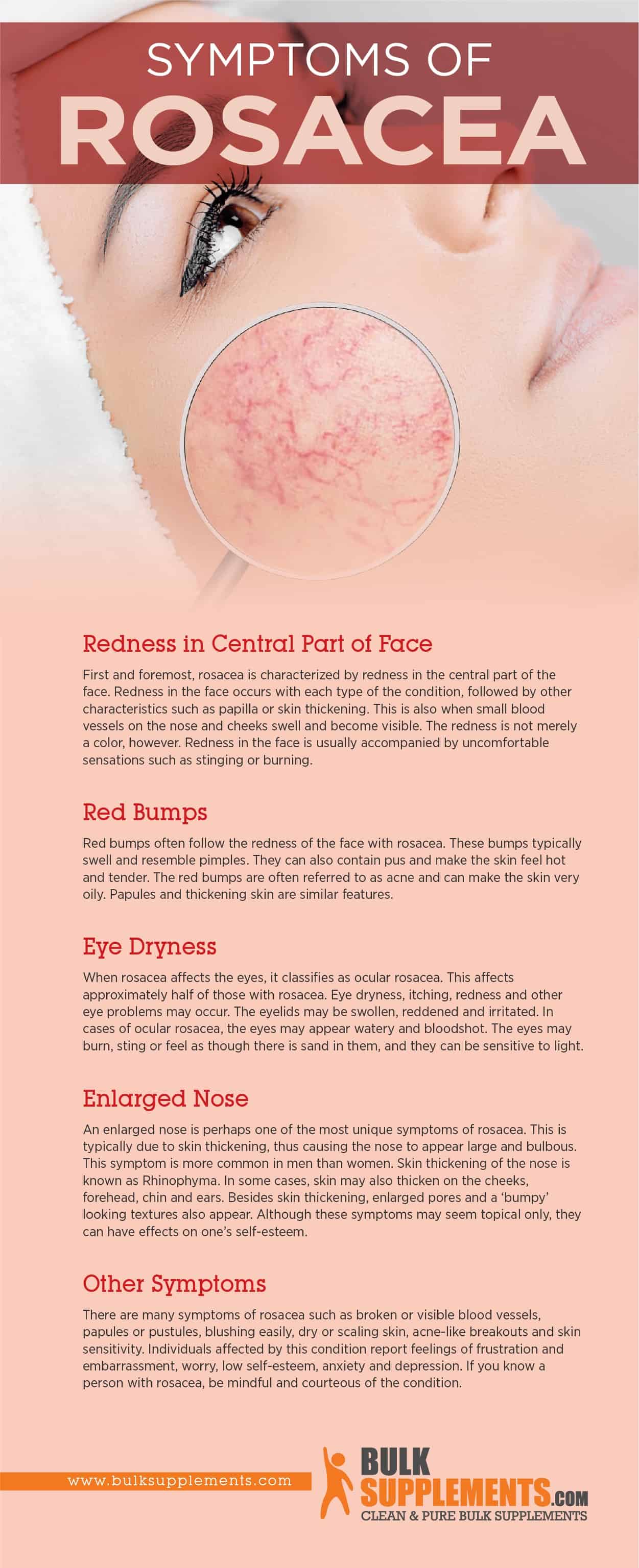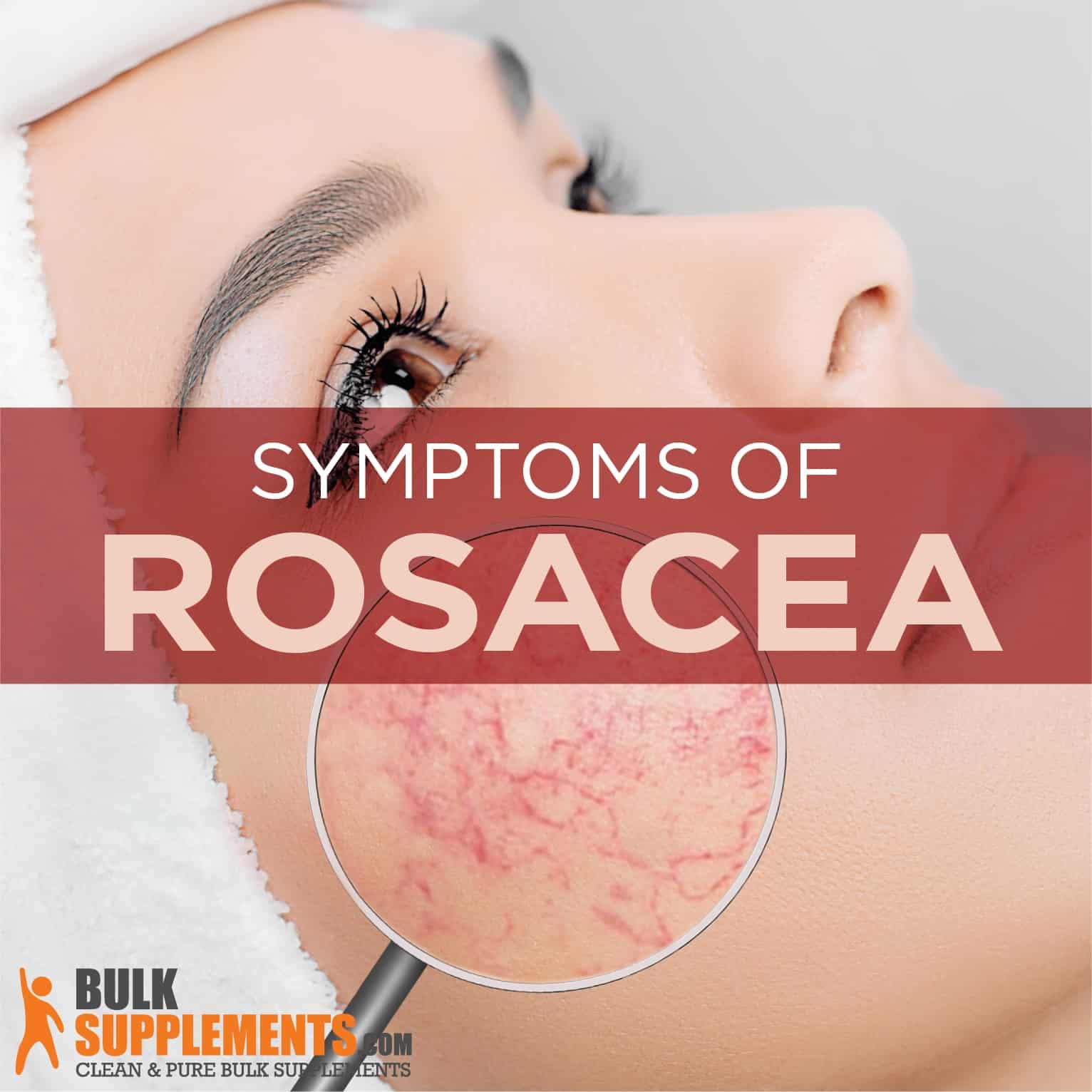The chances of you or someone you know having rosacea are pretty good, considering it’s a widespread skin disorder. It is a condition affecting some 14 million people (x) and surfaces with redness of the face, similar to a flushed or blushing appearance. Unfortunately, rosacea often spreads to your cheeks, ears, forehead and chin. It may even spread to your back and chest. Rosacea relates to skin plaque and can develop into four subtypes.
Individuals with erythematotelangiectatic rosacea may experience redness, flushing, and visible blood vessels. Another common type is papulopustular rosacea, which has redness, swelling and acne-like breakouts. With phymatous rosacea, the skin thickens and has a bumpy texture. Lastly, with ocular rosacea, the eyes appear red and irritated. The eyelids swell and might look like sties.
If you have rosacea, you are not alone. Princess Diana, Bill Clinton and many other famous public figures have had rosacea.
Rosacea Symptoms
Understanding the symptoms of this health concern can help you find the proper treatment. Some include:
- Redness in Central Part of Face
First and foremost, rosacea appears as redness in the central part of the face. Redness in the face occurs with each type of the condition, followed by other characteristics such as papilla or skin thickening. You may also see small blood vessels on the nose and cheeks that swell and become visible. The redness is not merely color, however. Redness in the face also has uncomfortable sensations such as stinging or burning. (x)
- Red Bumps
Red bumps often follow the redness of the face with rosacea. These bumps typically swell and resemble pimples. They can also contain pus and make the skin feel hot and tender. Some refer to the red bumps as acne and can make the skin very oily. Papules and thickening skin are similar features.
- Eye Dryness
When rosacea affects the eyes, it classifies as ocular rosacea. It’s a condition that affects approximately half of those with rosacea. Eye dryness, itching, redness and other eye problems may occur. The eyelids may swell, reddened and become irritated. In cases of ocular rosacea, the eyes may appear watery and bloodshot. The eyes may burn, sting, or feel like there is sand in them, and they can be sensitive to light. (x)
- Enlarged Nose
An enlarged nose is perhaps one of the most unique symptoms of rosacea. It’s typically due to skin thickening, thus causing the nose to appear large and bulbous. This symptom is more common in men than women. Skin thickening of the nose, known as rhinophyma. In some cases, your skin may also thicken on the cheeks, forehead, chin and ears. Besides skin thickening, enlarged pores and a ‘bumpy’ looking texture also appear. Although these symptoms may seem topical only, they can affect your self-esteem. (x)
- Other Symptoms
There are many symptoms of rosacea, such as broken or visible blood vessels, papules or pustules, blushing easily, dry or scaling skin, acne-like breakouts and skin sensitivity. Individuals affected by these conditions report feelings of frustration and embarrassment, worry, low self-esteem. If you know a person with rosacea, be mindful and courteous of their condition.
Did You Know This About Rosacea?
Unless you or someone you know has rosacea, few people know about this widespread condition. Many people often categorize it simply as acne alone, but this is not the case. It is a lasting condition with several risk factors, but mainstream medicine says no known cause. However, American College for Advancement in Medicine published an article on fungal overgrowth in the red blood cells, causing many diseases, a commonly overlooked cause in most medical practices. They include rheumatoid arthritis, dandruff, psoriasis, eczema and chronic allergies. (x) While we wait for scientists to get caught up to speed with this 2015 article, there are a few myths and facts to keep in mind:
Fact. You are more likely to suffer from this condition if you have fair skin.
Fact. It manifests from your family tree.
Fact. A mite that lives on everyone’s skin is a potential cause.
Fact. Women are more likely to get rosacea.
Fact: Men are more likely to have severe rosacea.
Fact. Vigorous exercise can trigger rosacea.
Fact. Excess fluid may leak from the skin.
Myth. Although it appears like acne, rosacea rarely has actual acne.
Myth. Rosacea does not affect work productivity.
Myth. Alcohol is not a trigger.
Myth. No connection between rosacea and your immune system. (x)

Rosacea Remedies and Supplements
Applying these remedies and nutritional supplements to your health concern is a positive course to take, but talk with your healthcare provider first:
- Aloe Vera
Aloe vera may treat a variety of skin conditions. This plant is emollient and moisturizing, which makes it a great topical agent for rosacea. Aloe vera has cooling, anti-inflammatory, redness-reducing qualities. You can purchase aloe vera gels at most drugstores and even harvest the plant yourself. It is possible to have an aloe vera allergy, so use with some caution. You can use aloe vera powder by making it into a gel — some recipes on the Internet call for vitamin C, Vitamin E or just gelatin and water.
- Chamomile
Chamomile is also highly moisturizing and helpful as a topical, herbal treatment. It may also be present as an ingredient in certain products, so look for chamomile when treating your rosacea. You can also use chamomile essential oil, diluted; apply cooled chamomile tea as a skin wash or compress.
- Coconut Oil
Coconut oil has moisturizing, antioxidant and anti-inflammatory effects. Studies report coconut oil is a natural product that has a lot to offer. You can use it as a carrier oil with other essential oil treatments. Research supports the use of coconut oils and other similar oils for calming rosacea symptoms, though these treatments included avoiding triggers and a healthier diet. (x) In case of allergens, you should always consult your doctor even before using a natural supplement.
Where to Buy Supplements to Improve Rosacea Symptoms?
You can purchase these powders and supplements for improvement of your rosacea symptoms at BulkSupplements.com. The company is an industry-leading manufacturer and distributor of pure dietary supplements.
BulkSupplements.com is not just a consumer brand. It also supplies pure ingredients to other food and supplement brands to make their products. All products at BulkSupplements.com are manufactured and tested according to current and proper manufacturing practices.
Are you interested in trying any of these powders or supplements mentioned in this article as a possible solution to helping you with rosacea symptoms? Contact BulkSupplements.com to place an order today.
Clean Up Your Diet
Diet plays a significant role in the severity of rosacea. Poor diet may cause increased flare-ups. Some things to avoid include hot foods and drinks, as well as alcohol. In addition, spicy foods, caffeine and dairy products may be problematic. If you have rosacea, it is better to avoid these foods as much as possible. (x)
Avoid Makeup
On some occasions, makeup is necessary. Makeup can be harsh on already sensitive skin and clog pores. Individuals with rosacea should avoid makeup during flare-ups and stick to a natural skincare routine. Learn which products work the best on sensitive skin and avoid harsh chemicals and products. This approach includes protecting the skin with sunscreen.
Other Remedies and Supplements
Natural remedies are ideal, but sometimes the right prescription is necessary, which doesn’t handle the deep-seated cause of rosacea. Your doctor may prescribe topical medications, oral antibiotics, isotretinoin, Blephamide or Tetracyclines, all specific to rosacea.
Laser treatment is also an option in which an intense pulse light can shrink the appearance of blood vessels. Plastic surgery is also an option for individuals with thickened skin.
Homeopathic therapies prescribed by a trained practitioner can work wonders and helps you resolve the health concern based on a natural approach. (x) Homeopathic is a system of treating the body with a holistic approach of giving your body substances that produce similar symptoms. It’s been around for over 200 years, originating in Germany. (x)
The Bottom Line
Rosacea affects approximately 14 million people. The condition is much more than just skin deep, too. Treating the disease begins from the inside out by changing your diet and finding a healthcare provider to help you determine what causes the health concern. Recent studies suggest fungi overgrowth is the primary cause of rosacea.
Having rosacea is discomforting both physically and mentally. The Internet has support groups, which offer shared realities and complementary alternative medicine treatments.
Though having this skin disease involves everyday life difficulties of interacting with others because of embarrassment, keep in mind you are not alone. There are solutions that you can follow to remedy this condition. Skin color (fair) and family descent have a prevailing connection to having this skin disease.
Supplementing your body helps along with changing to a healthier diet and avoiding factors that trigger rosacea.
These statements have not been evaluated by the Food and Drug Administration. These products are not intended to diagnose, treat, cure or prevent any disease.


